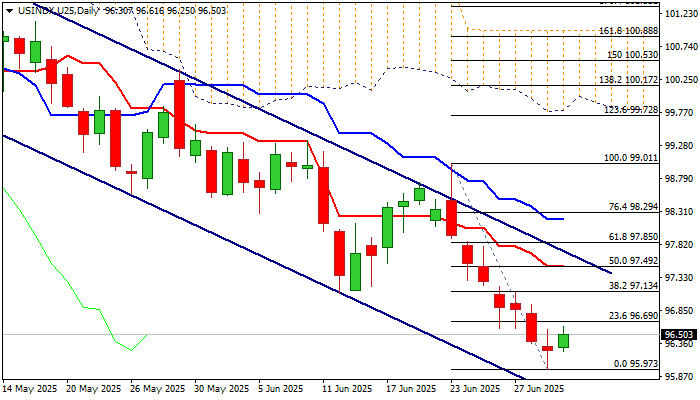Dollar index – Bears Hold Ground Above Multi-Month Lows as Markets Brace for Key U.S. Jobs Data
The U.S. Dollar Index edged slightly higher on Wednesday after hitting a fresh 3.5-year low, supported by a surprise jump in the JOLTS job openings report, which improved short-term sentiment and triggered some profit-taking.
However, the recovery remains limited, with the greenback still under pressure amid lingering uncertainty over President Trump’s massive $3.3 trillion tax and spending bill—recently passed by the Senate and now awaiting House approval.
Fed Chair Jerome Powell, meanwhile, reiterated the central bank’s dovish stance, maintaining a cautious “wait-and-see” approach to assess the potential inflationary and economic fallout from the U.S. tariff regime. While this stance offers some support to the dollar, it also reflects broader hesitation.
The dollar has posted its weakest first-half performance in decades, dragged down by global uncertainty, accelerating de-dollarization efforts, and a broader shift away from the U.S. currency.
More volatility is expected ahead of the July 9 deadline for Trump’s tariff enforcement, especially with ongoing unresolved trade negotiations involving Japan, India, and the EU. The potential for escalation if no deals are reached remains a key risk.
Tensions between President Trump—who is pressuring the Fed to lower borrowing costs to stimulate investment—and Chair Powell—who remains cautious due to concerns over rising inflation from tariffs—are adding further uncertainty to the dollar’s outlook.
Technical View:
The technical picture remains firmly bearish on the daily chart. Price action continues to struggle under a thick Ichimoku cloud, with the Tenkan-sen/Kijun-sen in a bearish configuration and momentum indicators pointing lower.
The index is hovering near the lower boundary of a bearish channel that originated from the May 12 high of 101.80, reinforcing the downside bias.
Upside corrections should ideally stay capped below the 97.50 zone—a key confluence of the 50% Fibonacci retracement of the 99.01–95.97 drop, the daily Tenkan-sen, and the upper boundary of the bearish channel. Holding below this area would keep broader bearish pressure intact.
A break below the recent low of 95.97 would confirm the continuation of the downtrend, exposing the next support at 95.18 (76.4% Fibo of the 89.15–114.72 uptrend from 2021/2022).
On the flip side, a decisive move above 97.50 would ease immediate downside pressure and open the path toward 97.85 (61.8% Fibo) and 98.18 (daily Kijun-sen).
Res: 96.69; 97.13; 97.50; 97.85
Sup: 96.25; 95.97; 95.18; 94.59


